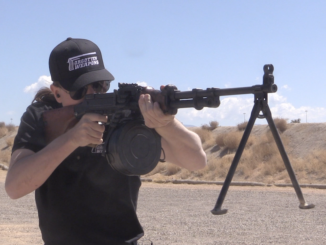In 1970 and 1971, China experimented with a stamped-receiver version of the SKS. About 6,000 of these rifles were made each of the two years, and a number of them have come into the US as commercial exports.
We don’t have any official records from China about this program, but it seems clear that this was an experiment to reduce the production cost of what was originally a relatively expensive, time consuming rifle to make. It’s easy to think of the SKS as cheap because of the prices they Brough in the US for many years, but in truth the SKS was a very 1940s sort of design with all milled parts. It is only the massive economy of scale from Chinese production capacity that made them cheap on the American market.
Anyway, circe 1970 China experimented with this stamped design, as well as a cast receiver. The stamped guns are most easily distinguished by the two rivets connecting the front trunnion to the receiver, which are half visible above the line of the stock. This example was made by factory 0138, but examples are also documented form factories 0139, 0144, and 0145. The only dates known are 70 and 71. In addition to the stamped receiver, these guns use cast rear sight blocks and gas blocks.
Thanks to Christian for lending me this cool rare version of the SKS to film for you!




With all SKS rifles banned in Canuckistan and soon to be confiscated now is a good time to alert northern owners that 1) SKSs aren’t all $100 gov’t compensation-value articles and 2) if you actually have a collectible one start filling out the paperwork to have it exported to a FFL dealer.
Here’s a hint, folks: Banning weapons does not uninvent them.
As an aside my youngest son went to the Peking Olympics in his official capacity, with the then UK Prime Minister, Blair. There he visited the Beijing Garrison Honor Guard Battalion, very impressive unit, all over six foot tall, and proportionately build. They then used the Chinese built version of the SKS, which they carried elevated over their shoulder, rigidly at attention for a hour at a time. He examined the SKS carried, they including the fixed bayonet made of hard plastic. The Type 95 Assault Rifles also used for ceremonial were the same.
Gordon:
Are you saying the entire SKS was plastic? You mean the Chinese are cheating? Perish the thought.
I suppose having plastic rifles reduces the chance of a member of the honour guard deciding to go Tonto on dear Chairman Xi, though even a plastic spike bayonet might do a bit of damage to old Winnie the Pooh.
why doesn’t this page show photos, just film? I don’t always want to watch a full film, but would like to see some nice pictures of the weapons in the articles here.
It was – 10 years ago :-))))
Second that. Aaahhh…..the good old days.
Is there a reason known, why the People’s Liberation Army had this love for the SKS? The Soviets pretty quickly changed over to all AK in the infantry seeing the advantages of having a do-it-all and only one standard rifle, that also is cheaper to make. The Chinese stayed with the SKS long past it’s due. Sure they had set up manufacturing, but they were also making AK Type 56 rifles. But they stubbornly stayed with it. Even making it fully automatic with the so-called type D. There must be something written somewhere about the why of procurement. In mandarin I guess.
and even in their Type 81, their love for the SKS can be found.
I guess they invested in expensive production capabilities, and tried to get the most out of them?
I had read that the Chinese kept about the SKS to give the majority of soldiers a weapon that was more conducive to accurate rifle fire over the long distances present in the Chinese mainland.
It seems fairly reasonable, I just can’t recall where I read it from so it may as well just be speculation.
“(…)why of procurement(…)”
https://smallarmsreview.com/the-sks-rifle/ claims that
Chinese production of the Type 56 (SKS) carbine was undertaken during 1956 by a large number of arsenals, and remained in production longer than any other country. In addition to military carbines, China made a large number of their commercial Type 56 carbines for export, primarily for the U.S. civilian market…
So maybe long production of SKS in PRC was caused not by PLA needs alone, but foreign customers? How much percent was delivered to PLA in each year of production?
They are BANNED to sell or transfer in the Peoples’ Socialistic Fascist Republic Of Washington. Does anybody know a gun shop owner in Idaho? Time to liquidate so the dictators don’t melt down our weapons.
Very interesting to get a “look under the hood” so-to-speak on this variant. I was frankly surprised that there was a less-common or even “rare” variant of the Chinese Type 56 SKS! I once had one with that plastic/ “phenolic” bakelite upper handguard. That one I let go, unfortunately, and was manufactured in 1980 if I recollect. Last year of production, or at least at that factory. I know Vietnam made some Simonov-type carbines, and unless I’m mistaken, Bangladesh ex-East Pakistan too? Certainly there were very, very many Chinese SKS exports to sub-Saharan Africa, Pakistan, Vietnam, and for quite a few years, the USA (at least from 1988 through 1994…) Who knew that among those millions, there were a scant two-year production of this variant?